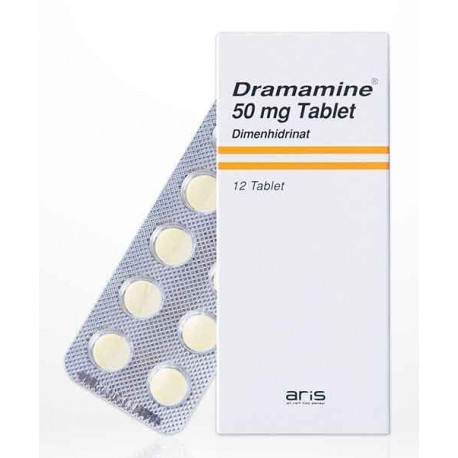 View larger
View larger Dramamine (Benadryl, diphenhydramine hcl) 50 Mg 12 Tablets
DRTMN3664
New product
BUY MORE PAY LESS
| Quantity | Discount | |
|---|---|---|
| 2 | 5% | |
| 3 | 10% | |
| 4 | 15% | |
| 5 | 20% |
Volume discounts
| Quantity | Discount | You Save |
|---|---|---|
| 2 | 5% | Up to $2.90 |
| 3 | 10% | Up to $8.70 |
| 4 | 15% | Up to $17.40 |
| 5 | 20% | Up to $29.00 |
More info
Active ingredient
Contains 50 mg Dimenhydrinate.
Excipients
Sodium sulphate anhydrous, Corn starch, Gum Arabic, CMC, Magnesium stearate, Propylene glycol, Ethyl alcohol, F.D.C. Yellow no.5 (E 102)
2. What is Benadryl and what is it used for?
Presented in a blister package containing 12 tablets in a Benadryl box.
They are smooth round, yellow colored tablets with a SEARLE print on one side and a notch on the other. It is in the group of anti-nausea drugs and each tablet contains 50 mg of dimenhydrinate active ingredient.
Benadryl is used to treat the following conditions:
• Motion sickness: Benadryl is used in the treatment or prevention of nausea, vomiting and / or dizziness caused by movement.
• Other Uses: It is used in the symptomatic treatment of diseases such as semen related to the balance organ (vestibular) in the inner ear.
3. How to use Benadryl?
Instructions for proper use and dose / frequency of administration
In the treatment of motion sickness:
50-100 mg (1-2 tablets) is used every 4-6 hours. It should not be taken more than 400 mg (8 tablets) in total in 24 hours.
In the treatment of Meniere's disease:
It is used 25-50 mg (1 / 2-1 tablet) 3 times a day.
Application route and method
Benadryl is used by mouth only.
Swallow the tablet with a glass of water, do not chew it. The first dose should be taken about half an hour in advance before starting action.
Different age groups
Use in children
In the treatment of motion sickness:
6-12 years: Every 6-8 hours, 25-50 mg (1 / 2-1 tablet) can be used. It should not be taken more than 150 mg (3 tablets) in total in 24 hours.
2-5 years: Every 6-8 hours, 12.5-25 mg (1 / 4-1 / 2 tablets) can be used. It should not be taken more than 75 mg (1.5 tablets) in total in 24 hours. Alternatively, it can be given as 1.25 mg / kg or 37.5 mg / m2.
It should not be used in children under 2 years of age unless prescribed by a doctor.
Use in the elderly:
Elderly patients should be careful when using Benadryl. Hypotension, hyperexcitability, anticholinergic effects may be seen.
Special use cases
Kidney failure:
Patients with renal insufficiency may need not to use Benadryl or to use low doses or to be kept under control throughout the treatment.
Liver failure:
Patients with liver failure may need not to use Benadryl or to use low doses or to be kept under control throughout the treatment.
If you have an impression that the effect of Benadryl is too strong or too weak, talk to your doctor or pharmacist.
* 'r ~
If you use more Benadryl than you should
Symptoms of Benadryl overdose include dizziness, seizures, convulsions, breathing difficulties, and death. If you have used more than you should use from Benadryl, talk to a doctor or pharmacist.
4. What are the possible side effects?
Like all medicines 4. What are the possible side effects?
Like all medicines, people who are sensitive to the ingredients of Benadryl may have side effects.
Side effects are listed as shown in the categories below.
Very common: It can be seen in at least 1 of 10 patients.
Common: less than one in 10 patients, but more than one in 100 patients.
Uncommon: less than one in 100 patients, but more than one in 1000 patients.
Rare: may be seen less than one in 1000 patients.
Very Rare: Less than one in 10000 patients can be seen.
Very common side effects:
• dizziness
Common side effects:
Drowsiness
Dry mouth and respiratory tract
Pain in the application area
Rare side effects:
Eating disorder (anorexia)
Blood diseases
Dreaming
• Nervousness
Nightmare
• Excitement
• Headache
Cognitive impairment
• Seizures
Dry mouth
Insomnia (especially in children)
• Fatigue
Optical changes such as blurred vision, double vision
Tinnitus
Excessive heart rate (extrasystole)
Acceleration of the heart rhythm (tachyarrhythmia)
Low blood pressure
Blood disorder
Dryness in the nose
Dryness in the throat
Cramping abdominal pain
Nausea
Vomiting
Constipation
• Diarrhea
Decreased appetite
Dry mouth
Skin rash
Itching
Itching / swelling of the skin (especially face, tongue, throat)
Sensitivity to light in the skin
Excessive sweating
• There may be side effects in people who are sensitive to the substances in the content of painful urination.
Side effects are listed as shown in the categories below.
Very common: It can be seen in at least 1 of 10 patients.
Common: less than one in 10 patients, but more than one in 100 patients.
Uncommon: less than one in 100 patients, but more than one in 1000 patients.
Rare: may be seen less than one in 1000 patients.
Very Rare: Less than one in 10000 patients can be seen.
Very common side effects:
• dizziness
Common side effects:
Drowsiness
Dry mouth and respiratory tract
Pain in the application area
Rare side effects:
Eating disorder (anorexia)
Blood diseases
Dreaming

